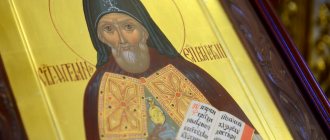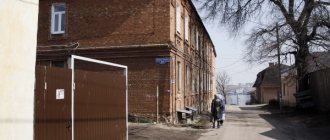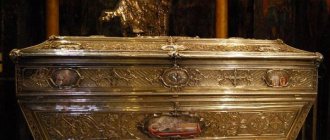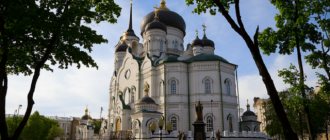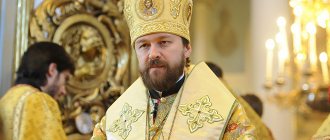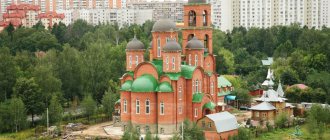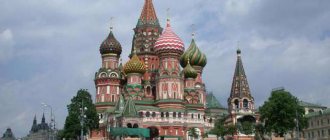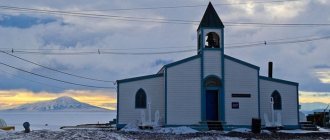In recent years, mass church construction has become a common thing in Russia. Voronezh is no exception. Construction of the Mitrofan Church at the source began in 1998, and the work was completed 11 years later.
Although the current church of St. Mitrofan in Voronezh is a new build, it still has historical roots. Not far from its location, the Mitrofanievsky Monastery previously stood - a famous landmark in the city.
Lost Mitrofanovsky Monastery in Voronezh
However, after the establishment of Soviet power in the city, the monastery lost its influence on city life. Its buildings fell into disrepair, and during the Great Patriotic War they were completely destroyed. After the end of the fighting, when the Voronezh residents lived in dugouts and worked under temporary sheds, no one bothered to reconstruct the buildings of the destroyed monastery. Now in their place stands a temple of a different kind - the main building of Voronezh University.
Church of St. Mitrofan in Voronezh
History of the temple
Mitrofanevsky Church was named after the first Voronezh bishop. Mitrofan of Voronezh lived a long life, and for more than 20 years he led church affairs in Voronezh. Near the now disappeared monastery (also named after the bishop) there was a spring that was associated with his name. Believers attributed healing properties to water.
The monastery disappeared, but the spring not far from the embankment and the Assumption Admiralty Church remained. For a long time, the area near it was a zone of informal “gatherings in nature.” But in 1993, a plot of land with a spring was transferred to the Voronezh diocese.
Mitrofanovskaya Church at the source
Construction of a new church on this site began in 1998. The author of the project was the architect A.G. Fedorets. A number of city construction companies were involved in the construction work. Funds for work and materials were provided by Voronezh entrepreneurs B.G. Kolbeshkin, S.D. Ishchenko, B.M. Skrynnikov and others.
The work took a lot of time. By 2006, only the side tower of the Mitrofan Church was ready. In 2008, work on the central part was completed, and a lightweight light drum was delivered from Volgodonsk. Officially, services in the new church began to be held in August 2009. But only a year later the work on the baths at the source was completely completed and bells were installed (7 pieces, 6 of which were donated by A.I. Balyasnikov).
Church of St. Mitrofan, view from Sophia Perovskaya Street
Many churches in Voronezh are now technically advanced. And Mitrofanievskaya is no exception. She has an official website on the Internet, with the help of which you can not only find out the schedule of services, but also order services online. The temple also has its own groups on the social networks VKontakte and Instagram.
Temple architecture
Although the Church of St. Mitrophan of Voronezh is relatively new, historical traditions were taken into account when designing it. The church can safely be considered one of the examples of Peter the Great's Baroque.
Temple courtyard, central part
In plan, the building is a square with an open courtyard. It has 4 domes: the main one, 2 above the side towers and the bell tower dome. The entrance to the courtyard is located under the bell tower. The color scheme of the building is white and blue, as was typical of Peter the Great's Baroque.
Inner courtyard of the Mitrofan Church
The maximum height of the building (in the central part) is 32 m. The bell tower is noticeably lower - 16 m. In addition to the church building, on the territory of the temple there is a Mitrofanovsky spring, associated with the name of the Voronezh bishop.
Bell tower and central dome of the temple
Church of St. Mitrophania of Voronezh at the Mitrofanievsky Orthodox Cemetery
since the site, which until recently was the main source of information about the cemetery
https://mitrofan-spb.ru/
no longer works, I consider it necessary to copy the existing information
===================
On April 10, 2014, in the Prince Vladimir Cathedral on the Petrograd Side, deputy Andrei Yuryevich Anokhin handed over declassified documents from 1933 and 1934 to the rector of the parish of the Church of St. Mitrophan of Voronezh, Priest Maxim Kosykh. from the Central State Archive of Historical and Political Documents of St. Petersburg, which shed light on the history of the desecrated Mitrofanievsky cemetery. Documents indicate the use of tombstones for the construction of the House of Soviets in the Narva region. The transfer of documents was attended by the rector of the Prince Vladimir Cathedral, Archpriest Vladimir Sorokin, a member of the Council for the Preservation of Cultural Heritage under the Government of St. Petersburg, architect Rafael Maratovich Dayanov, and the head Alexander Nesmeyanov. Representatives of St. Petersburg media. Also at this meeting, the state of affairs regarding the Mitrofanievsky cemetery was discussed in connection with the development of the issue of its borders and the restoration of Orthodox churches on it. TsGAIPD St. Petersburg provided Andrei Yuryevich with five documents that mention the Mitrofanyevskoe cemetery, namely: - An extract from the resolution of the Presidium of the Leningrad Council of February 21, 1932 “On putting Leningrad cemeteries in order”; — Appeal from Kalinin, K. Martyanova, Ivanovsky, Rubtsov and others to Comrade Kirov dated April 12, 1934; — Protocol of interrogations of A.S. Korovin and P.S. Svyatsky, produced by the Head of the Narva District City Division - Turovsky on May 9, 1934; — Memo dated May 10, 1934, signed by assistant chief of the SPO Mosevich; — Certificate about the dismantling of the Mitrofanyevskoye cemetery signed by the head of the Narva Russian Geographical Society Turovsky in May 1934. “Information about the dismantling of the Mitrofanyevskoye cemetery: The dismantling of the Mitrofanyevskoye cemetery began after the publication of the decree of the Leningrad Council of February 21, 1932 with the removal of metal products - gratings, crosses, metal monuments, slabs, etc. In total, several thousand tons were removed from the cemetery. Marble and granite monuments from the cemetery began to be removed for the first time in July 1933 by the Marble Saw Plant, which produced distribution boards for Svirstroy. The Marble Saw Plant received the rights to export marble from the Narva Rafinsection, which is the distributor of ownerless property. The Rafinsection and the plant entered into an agreement for the export of marble, to which was attached a list of ownerless monuments. These lists contain a clause that the demolition of monuments for which statements about their historical significance or ownership are received, will be carried out in each individual case with the approval of the Regional Financial Section and under the supervision of the Funeral Business Trust. In September 1933, the House of Soviets under construction in the Narva region was decided to be plastered externally with marble chips. This issue was also discussed in the Leningrad City Council, because marble plaster significantly increases the cost of construction. After a positive resolution of this issue, the Housing Section of the Narva District, by order of the Chairman of the Council, Comrade KIRYANOV, and in agreement with the Regional Financial Section, began developing monuments, and official supervision of this work was received by the construction administration of the Council House. The work of removing the monuments at the cemetery was directly supervised by the construction agent Khapugin, who, according to the statement of the workers of the Rafinsection and the construction of the Council House, was obliged to coordinate with the caretaker of the cemetery the dismantling of the controversial monuments. Legally, he had the right to disassemble monuments only those noted in specially compiled lists. In total, up to 100 cubic meters were removed from the Mitrofanyevskoye cemetery for the construction of the Council House. marble and 50-60 cubic meters. granite At the same time, the rubble slabs were excavated and several hundred cubic meters were removed from the cemetery. In October-November 1933, when plastering of the Council House with marble chips began, the construction was inspected by Comrade Kirov, who was shown samples of the colors of the plaster to finalize the color. According to the chairman of the Narva District Council, Comrade Kiryanov, the latter allegedly reported to Comrade Kirov that marble chips were being made from ownerless monuments taken from the Mitrofanievskoye cemetery and that Comrade Kirov allegedly confirmed the correctness of this decision. The chief engineer of the construction of the Council House, interrogated by the Russian Geographical Society, P.S. Svyatsky. showed that during the dismantling of the monuments, a complaint was actually received that a monument-slab of historical significance had been removed; he definitely did not remember the poet or writer. They were immediately instructed to put the slab in place. A check on the execution of this order was carried out by a member of the Presidium of the District Council, Petrov. In addition, a complaint was received regarding the construction about the dismantling of a number of monuments that were not subject to demolition. The interrogated inspector of the State Funds of the Raifin Department, Korovin, testified that the construction agent for the Council House, Savelyev, who came to him to negotiate on the removal of monuments from the cemetery, told him: “by order of Comrade Kirov, all unowned items can be taken for the construction of the Council House - monument, marble, etc.” . Head of the Narva Russian Geographical Society Turovsky .. May 1934.” In particular, the collection of documents contains an appeal from citizens to Comrade Kirov with the following content: “We inform you that, in accordance with your order, the use of stone and marble from the mismanaged graves of the Mitrofanievsky cemetery for the construction of the House of Soviets of the Narva region was carried out disgracefully by the relevant organizations. The aimless, hooligan destruction of protected graves and monuments causes constant protest from those visiting the cemetery. To our complaints, the Narva Council and the Cemetery Administration (Nakhimson Ave.) respond that everything is being done on the orders of Comrade. Kirov. Please find the real culprits and bring them to justice
Mitrofanovsky spring and fonts
They say that the source, consecrated in 2012, has the ability to heal various ailments - from the runny nose to infertility. These miracles became possible thanks to the holiness of the first Voronezh bishop, who liked the spring as a platform for solitary reflection.
For a long time, the spring remained wild, although water was often drawn from it. After the transfer of the land plot with the spring to the church, landscaping work began near it.
Entrance to the territory of the Mitrofanovsky spring
Believers visiting Voronezh are primarily attracted to the Mitrofanevsky spring. It is believed that you can be treated either by drinking water or by plunging into it. Therefore, the improvement of the source included not only the construction of a site for water intake, but also baths - open and closed.
Outdoor baths are located in the fresh air, directly at the spring’s outlet to the surface. There are changing cabins nearby. The bowl for collecting water and the baths themselves are lined with red brick, and the entire complex represents one of the structures of the church.
One of the indoor baths with spring water
In the right wing of the church there are closed baths (separately for women and men). The spring water is supplied there through pipes. On this basis, the Mitrofanievskaya Church is rightfully classified as the Voronezh “temple at the source.” The healing power of water is intended to increase the lighting of the baths in accordance with church canons.
Stories about Bishop Mitrofan and the special properties of the water from his favorite spring constantly attract parishioners to the new church. People often come here from afar on purpose.
The foundation of the Voronezh temple
The construction site is famous for the source of holy water; pilgrims from all over the country come here in large numbers to get rid of serious illnesses. The saint himself loved to visit this corner and chant prayers for a long time.
- Glory came to the source after the first case of healing was recorded. Miracles have been happening in this place for three centuries: people are getting rid of infertility, headaches, colds and other diseases.
- Until 1993, the spring was not developed, but today pilgrims have the opportunity to stay near the spring and get enough of the presence of holiness.
Holy spring of Mitrofan of Voronezh - In the Church of Mitrofan of Voronezh there are special baths, ready to welcome everyone. To get water from the source, craftsmen made drains through a pipe.
On a note!
The church has its own website (https://mitrofan-hram.ru/), where anyone can see the schedule of services. On Thursday, an akathist to Saint Mitrofan is sung here, on Saturday the All-Night Vigil is celebrated, and on Sunday from 9.00 there is a Liturgy. Classes at the Orthodox school are scheduled for the weekend.
Temple shrines
- Cross brought from Jerusalem
- Ark with the relics of the holy noble princes Fyodor, David and Constantine
- Ark with a particle of the relics of the Holy Blessed Matrona of Moscow
- Ark with the relics of the Hieromartyr Cyprian and the Martyr Justina
- Myrrh of St. Nicholas the Wonderworker, brought from Bari
- Metal icon of St. Mitrofan
- Icon of the Mother of God “Mammal”
- Icon with a particle of the relics of Saints Peter and Fevronia
- Icon with a particle of the relics of St. Nicholas the Wonderworker
- Icon with a particle of the relics of St. Spyridon of Trimythous
- Icon with a particle of the relics of St. Luke of Crimea
- Icon with a particle of the relics of the Great Martyr Panteleimon
- Icon of Simeon of Verkhoturye with a particle of relics
- Icon with a particle of the relics of the Holy Blessed Matrona of Moscow
- Icon of the Savior with a piece of the Robe
- Icon of St. Nicholas the Wonderworker (solid chasuble)
- Iveron Icon of the Mother of God of the 18th century.
- Icon of the Mother of God “Inexhaustible Chalice”
- Icon of the Mother of God “Addition of Mind”
- Icon of the Great Martyr Basilisk
Author: Maria Goncharova
